(400 million people are expected to gather at the confluence of the Ganga, Yamuna, and Saraswati rivers near the city of Prayagraj for a holy dip from January 13 to February 26, 2025. This 45-day festival is called Kumbh Mela. I will be visiting this festival from February 1-5, 2025.)
I returned from Kumbh Mela on February 5, 2025 and found myself paralyzed by the sheer intensity of stories and experiences. I am still overwhelmed, still soaking it in and still struggling for words. It will take a while for me to peel my mental inner layers and articulate the impact of this experience. This article addresses common questions about the Kumbh Mela (Part II). For additional questions and answers, please refer to Part I (1).
Q: What is the size of the Kumbh Mela grounds, and how are the sectors organized?
A: A: The Kumbh Mela grounds span approximately 5,000 hectares (50 square kilometers). While the area is vast for individuals to traverse on foot, it’s awfully compact for accommodating 10-100 million people who gathered on Basant Panchami day during my visit A round trip from my camp to Arial Ghat, through the temples in Sector 4 and the Akharas in Sector 20, and back to camp covered 25-30 kilometers. That is a killer walking in one day. This exhausting journey was necessary for two of the three days, as the administration had banned all vehicles except for ambulances and police transport.

Note that the entire Kumbh Mela is situated within the dusty, sandy riverbed of the Ganga-Yamuna confluence. There are no trees and no shades. At early morning, the temperature is cold 5-8°C (41-56°F). Throughout the day, bright sunshine raises temperatures to 30-33°C (85-90°F). Although toilets were abundant, I wasn’t confident about finding them quickly when needed. Consequently, I limited my water intake, which increased my fatigue.
I had to prioritize my activities. I skipped the temples entirely and used local motorbikes for one day. The walks on the other two days were exhausting but exhilarating, filled with activities and interactions.
Q: How was the infrastructure at the Kumbh Mela?
A: The infrastructure was excellent. As I mentioned above, the entire Kumbh Mela city was built on the sandy riverbeds of the Ganga and Yamuna. The Kumbh Mela area contained 450 kilometers of temporary roads, constructed by bolting 4′ × 12′ × 1″ iron slabs into the sand. The main roads were wide enough to require ten slabs across. Thirty pontoon bridges, each 1.5-2 kilometers long, spanned the Ganga and Yamuna rivers. The temporary city boasted a clean drinking water network superior to those found in many permanent Indian cities. Clean water was accessible every 100-200 meters via ATMs and taps for all visitors. The tent city, comprising 350,000 small tents and several massive warehouse-style structures, had an excellent sewage system. The administration installed and maintained 150,000 toilets. While not connected to the sewage system, these facilities were cleaned frequently. The entire city was brilliantly illuminated with 24/7 electricity, especially for the peak crowds during Brahma Muhurt (the auspicious time from 1-3 AM).
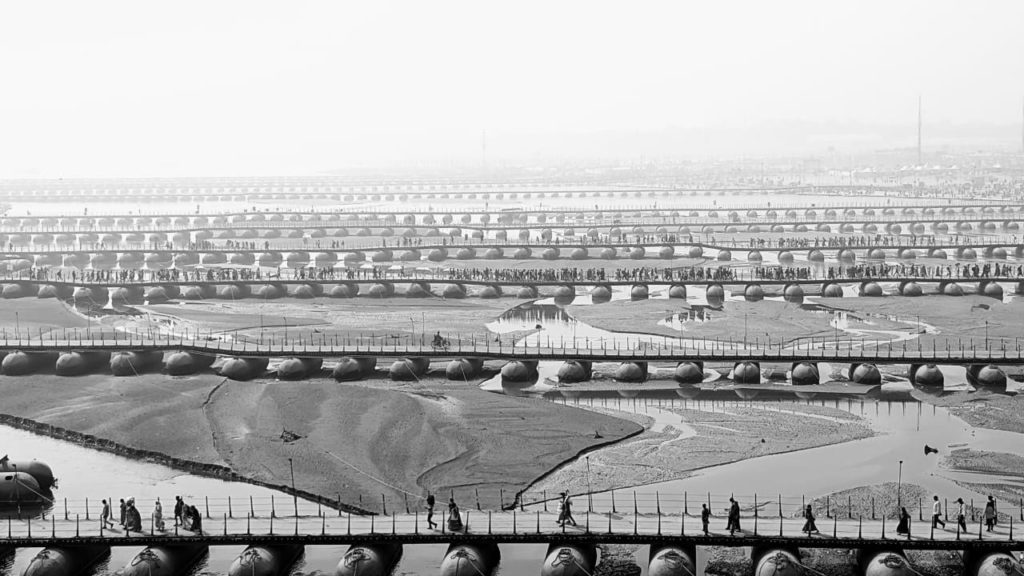
There is a network of speakers across the entire city of Kumbh Mela. With over a quarter million people becoming separated during the festival, speakers throughout the city broadcast lost individuals’ names in both Hindi and their native languages. Many of those who become separated are elderly individuals who can neither read nor write and speak only their mother tongue. Such lost and found centers were located every 400-500 meters along the main roads. To support the primary purpose of bathing in the Ganga, numerous changing rooms (small tents) were provided for women and children. Nine new railway stations handled thousands of daily trains, bringing vast numbers of pilgrims to the festival. Large parking lots were established around the perimeter of the Kumbh city. And, yes, unlike many other Indian cities, waste bins were placed throughout the grounds.
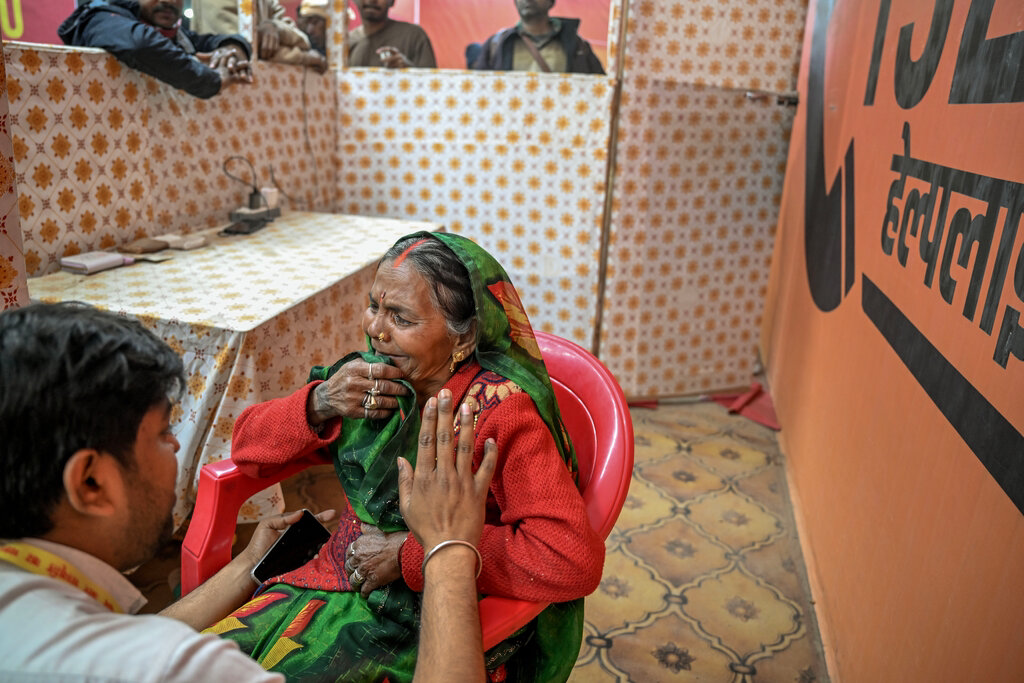
Security infrastructure included hundreds of drones, 2,500 CCTV cameras monitored by a central control room, and 150,000 police officers patrolling by foot, horse, boat, submarine, helicopter, and vehicle. Apparently, the control room used AI to monitor crowd density and redirect people as needed. Barricades in the water kept people within safe, shallow areas, protecting them from the Ganga’s strong currents. Fully equipped hospitals operated on both river banks. According to the doctors in our group, these hospitals matched the equipment standards of modern facilities in cities like Mumbai and Pune.
Should this plan be expected from the government? I think so. Is the plan being executed well? The answer is “Yes”. For that execution, I would give them “A” grade. But now here are the kickers for which the administration got “A+”.
I observed or talked to 20-30 police officers. I have never encountered a more polite police force. One fellow was hurling severe insults at the police with the choicest words (addressing police’s mother!) for not opening the pontoon bridge. And what did the police do? The police responded by respectfully folding their hands in namaste while firmly maintaining that the bridge must remain closed. Wow! Unbelievable scenario! I asked other police about their approach. They explained, “Everybody coming here is a divine being. It’s our privilege to serve them.” What the heck? Really? I would give them straight, straight “A+”.
A 15-meter-wide layer of dry grass lined the riverbanks throughout the Kumbh city. This thoughtful provision prevented sand from sticking to devotees’ feet after bathing—another example of exceptional planning. That is another straight “A+”. Maintaining the cleanliness of both the rivers and their banks was a monumental task. Yet there was no plastic, paper, or even the usual ubiquitous marigold flowers used in puja (prayers) visible on the riverbanks. This level of cleanliness was remarkable and exemplified the exceptional standards maintained throughout the Kumbh Mela. That is “A+”. One may find such “A+” situations all over Kumbh Mela.
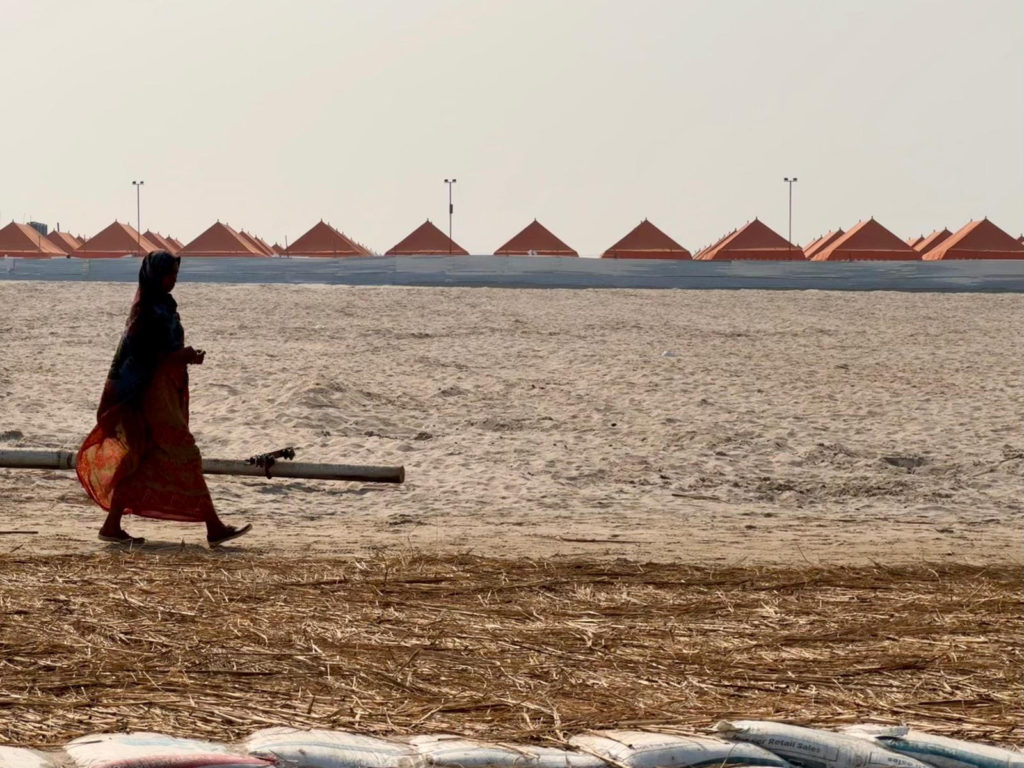
However, even the government’s extensive efforts alone would have been insufficient for managing 400 million people. The most significant observation from my visit was the self-managed nature of the Kumbh Mela. I will explore this aspect in greater detail in my forthcoming article.
However, the permanent infrastructure in the state of Uttar Pradesh falls significantly short of expectations. The distance from Prayagraj airport to our camp is at most 15-20 kilometers, typically a 45-minute drive. However, since the Naini Bridge—the only crossing point—was blocked, we had to take a circuitous 300-kilometer route via Mirzapur, which took 5-6 hours to reach our campsite.
Q: If planning and infrastructure was excellent, how could stampedes happen?
A: Two tragic stampedes have occurred during the event. The first occurred during Mouni Amavasya at the confluence at 1:00 AM, resulting in 40 fatalities. The second incident took place at New Delhi Railway Station, 800 kilometers away, involving Kumbh pilgrims. These were heart-breaking episodes. I have developed a deep emotional connection with the Kumbh Mela and its devotees. I literally wept on both occasions. I had hoped for a safe travel for everybody. But that was not to be.
Was I anxious about my own travel after first stampede? No, I was not. For more details, please read my blog post titled “My Journey of Confronting Fear.” (2). It sounds very harsh, but In hindsight, the probability of a stampede occurring was nearly certain. However, the sheer number of attendees meant that the probability of any specific individual becoming involved in a stampede was extremely low.
The administration implemented additional safety measures on the auspicious day of Basant Panchami during my visit. All vehicle traffic was closed. Not even bicycles were allowed. All river crossings were closed, and pilgrims were required to bathe at their point of arrival rather than at the confluence. Pedestrian traffic was strictly controlled in a one-way system. Only media personnel were permitted to observe the sadhus’ procession to the Ganga for their sacred bath. These comprehensive safety measures ensured a secure bathing experience for all participants.
Q: How clean was the Ganga?
A: I swear, I swear, I can emphatically confirm that the water was clean. From my camp, I could clearly see a large school of fish at the bottom of the river, approximately 1.5 meters (4.5 feet) deep. The attached photograph shows birds in the river’s center—a scene impossible to capture in polluted waters. Throughout my stay at the camp, I did not observe any plastic bottles or paper waste floating in the river. In certain barricaded shallow areas, I did observe marigold flowers floating in the water. But the banks were clean. It helped that Government has enforced shutting down of all the industrial waste water entering the upstream river for hundreds of kilometers. Additionally, visitors were continuously reminded to maintain the Ganga’s cleanliness. Naturally, this wasn’t comparable to a pristine Detroit suburb with manicured lawns. After all, this was a river bed. It was muddy and dusty everywhere, but definitely not dirty.

You might find this difficult to believe. There were millions and millions of people taking bath. The visitors came from towns and cities that typically lack proper sanitation. There were probably merely 50,000 people cleaning this area. AND Ganga was clean! Never ever I thought that this level of cleanliness was possible.
But what about millions of people bathing in the river? What about their perspiration, bacteria and undisciplined secret peeing in the river? Well, unlike a swimming pool, the river’s rapid flow constantly refreshes the water. People bathed here precisely because the water is considered sacred. Those concerned about such matters might want to reconsider visiting the Kumbh Mela.
Q: How was my tent?
A: As a trekker, I was ready for a minimalist tent. However, this tent was exceptionally luxurious. It featured a double bed with a comfortable mattress, comforter, standard pillows, and even decorative cushions. There were sofa and chairs in the main room and easy chairs in the verandah. The amenities included 24-hour running water and electricity, hot showers, Western-style toilets, in-room tea and coffee facilities, ceiling fans for warm afternoons, and fresh towels available upon request. The accommodation also provided secure lockers for valuables, Wi-Fi connectivity, and evening entertainment programs. Can you believe that this entire infrastructure was constructed on sand for just 45 days. Though expensive, the tent exceeded all expectations in terms of luxury and comfort.
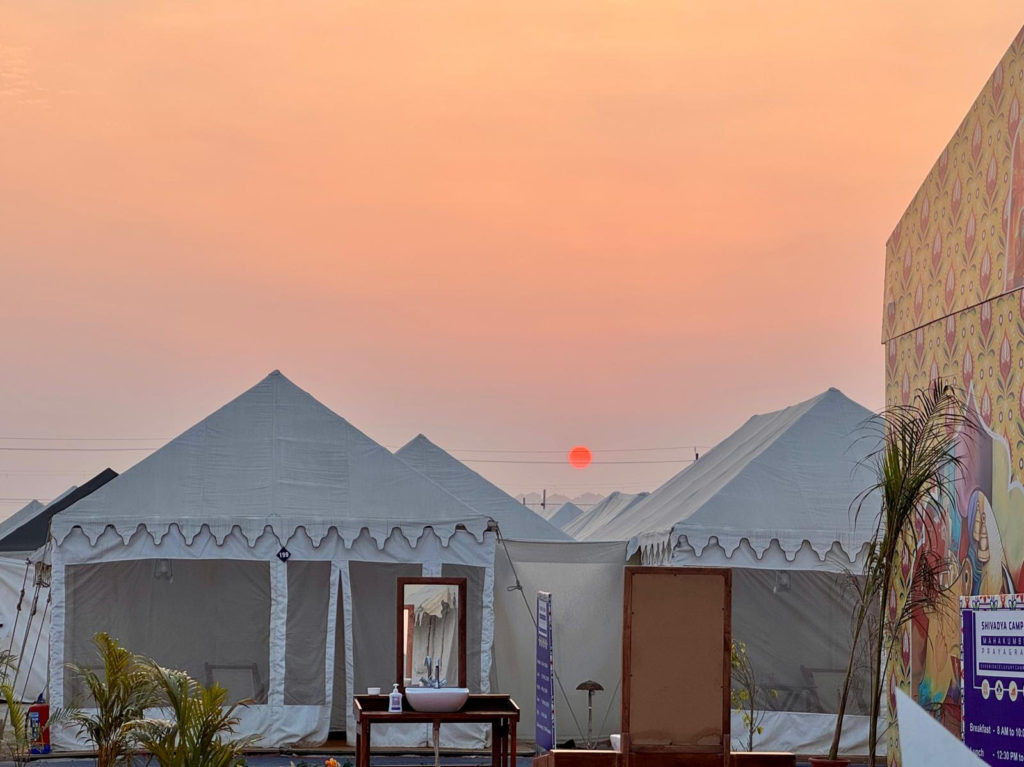
The dining hall accommodated 250-300 people and offered an impressive buffet featuring reasonable quality of cuisine. The Ganga River was merely 20 steps away, perfect for quiet prayer, and the entire premises were immaculately maintained.
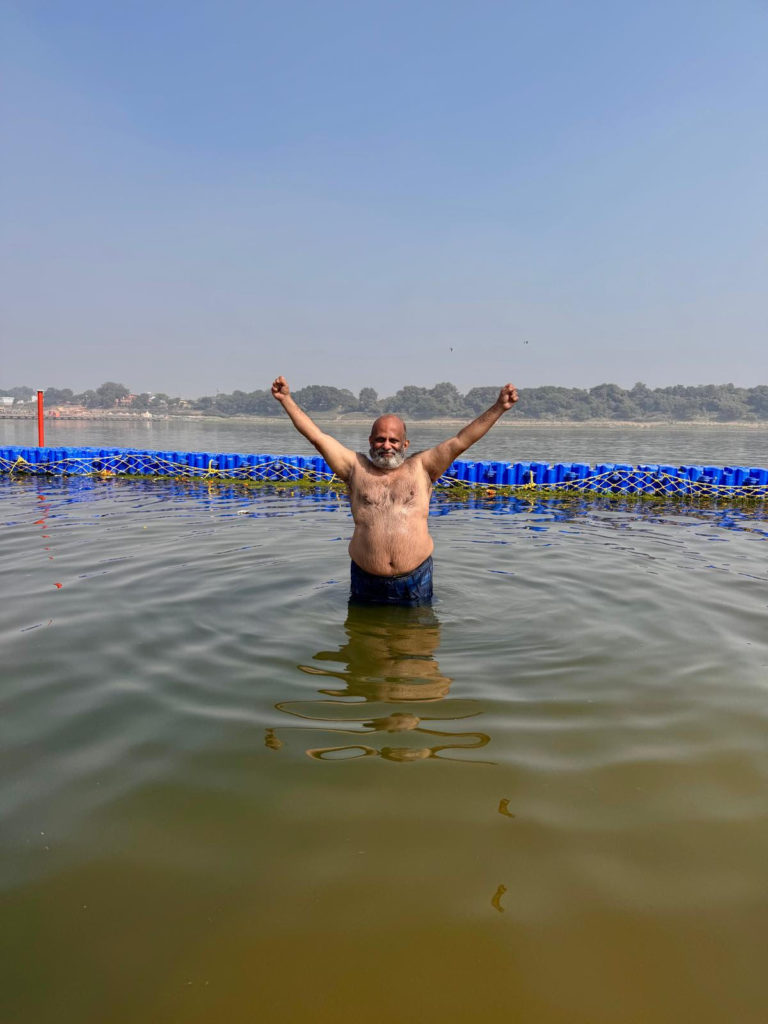
I have now completed my questions and answers (in this and the last article). In next few blogs, I will try to articulate the impact of Kumbh on me.
– Nitin Dadhi Anturkar (17th Feb 2025)
Acknowledgment:
The majority of photographs featured in my Kumbh Mela blog series were taken by me personally. Some photographs were contributed by friends who accompanied me to the Kumbh Mela..
(1) https://www.dadhionthetrail.com/2025/02/13/kumbh-mela-4-understanding-its-purpose-scale-and-celestial-significance/
(2) https://www.dadhionthetrail.com/2025/01/31/kumbh-mela-preview-my-journey-of-confronting-fear/


Very detailed nice post.All answer of anticipated questions.
Great no word to express. Missing all experience.
Thanks Dadhi for a detailed description of your experience and the facilities out there. It’s almost as if one was there personally
Thanks Nitin for an extensive coverage! You are the Best!
Good to see that the arrangement in prayagraj exceeded your expectations.
Happy to get a perspective from somebody who has stayed in a developed world for long, notwithstanding your affinity for India. Really good to know that this level of congregation happens in such a planned manner….
Nitin, you have very vividly created the actual scene in front of us. Huge thanks to you. The scale of the infrastructure and its quality plus its administration must be unparallel in the world . huge credit to the state government and administration .
Look forward to your experiences.!
Thank you so much for appreciating arrangements, hygiene @ world’s largest religious event. Looking forward to receive your experiences / dialogue with sadhus / priests.
Good to know that you have finished describing the material details with this post. Eagerly awaiting for the next article.
Did you manage to ask any of the Sadhus about their interactions with other Sadhus and other Akhadas; did you manage to ask about their elections?; did you ask if money plays any part in their choices? and in general, did you get a fair idea of the kind of interaction that takes place between the ascetics and the common people; and also between two groups of ascetics?
In short, how was the knowledge and experience flow during the Kumbha?
This is what I was waiting. I read it again today and felt like I have to reply…. Thank you for recreating the actual experience for readers and felt like we were there with you.
Will need to sit down and talk more…
Congratulations on you successful Kumbha Yatra 🙏. 🙂
Thank you, Dadhi, for your detailed description of your physical surroundings. That tent sounds luxurious. I am looking forward to reading about your spiritual experiences. Honestly, just listening to the sounds of India makes me want to go back.